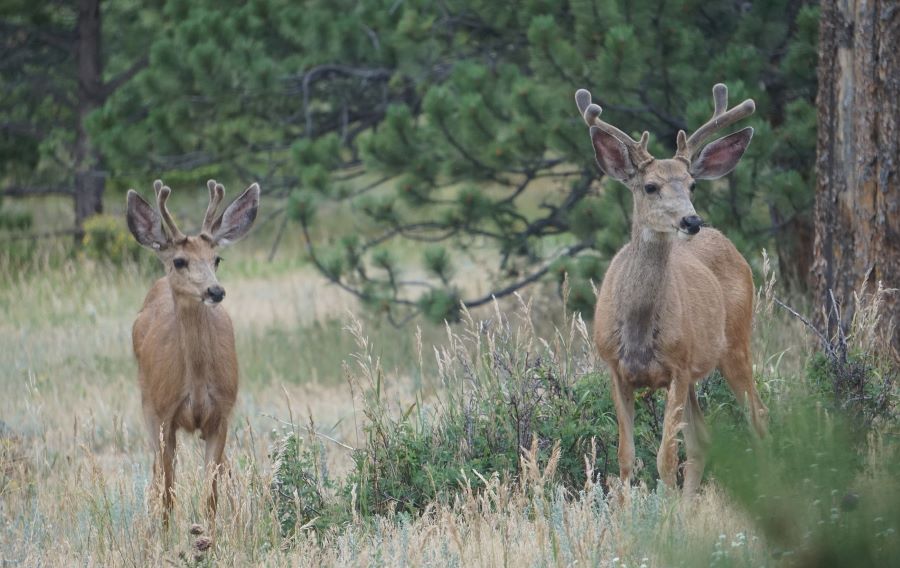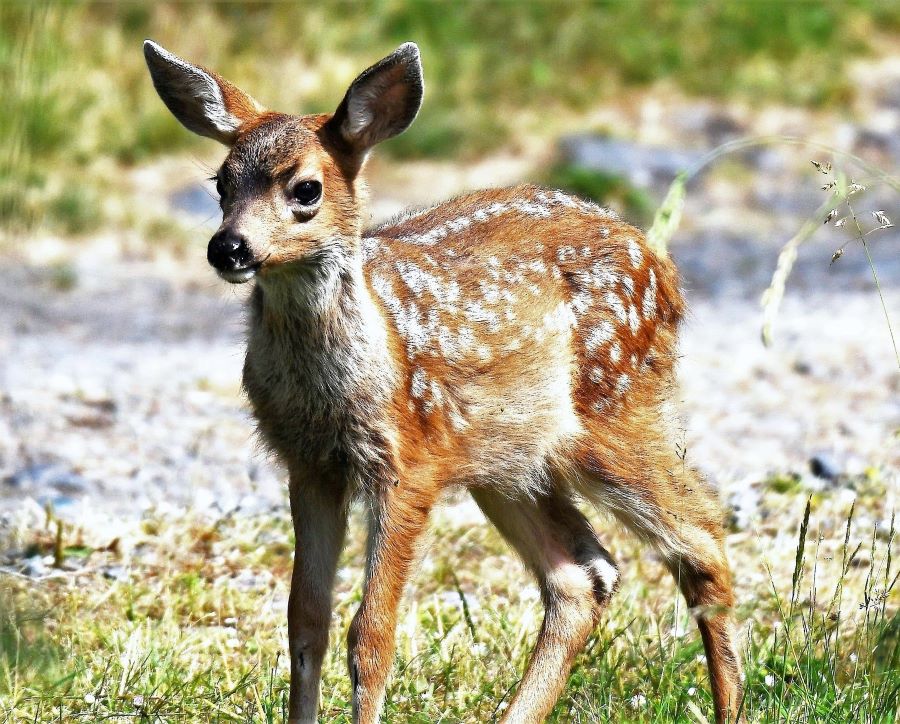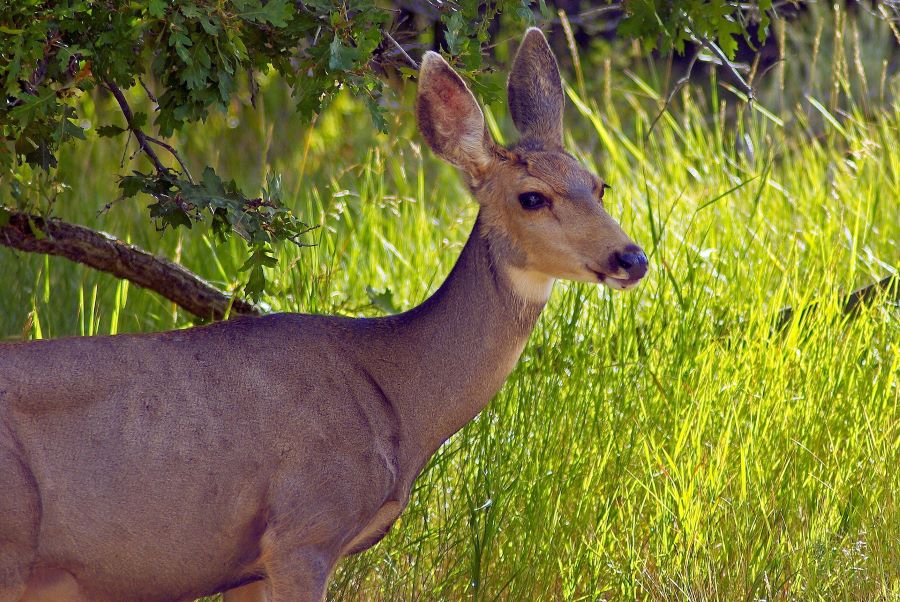Deer are becoming more present in our home landscapes and they’re eating our plants. More and more of us are moving into rural and suburban home sites… onto land that’s usually good deer habitat. This means they have less territory to roam and less food resources to depend on.
Deer are actually quite choosy about their food
They carefully select their plants based on their past experience with a plant, the deer’s nutritional needs at the time, plant palatability, the time of the year, what other food sources are available to them, and weather conditions.

Credit: patteybleecker from Pixabay
Deer need nutrient-rich plants, especially in the spring and summer when the does are pregnant and nursing, when young deer are growing, and when bucks are growing their antlers—which takes an enormous amount of food energy! (Read all about a deer’s antler growing process–it’s quite fascinating!)
Here’s what they like most
Fertilized plants in our home landscapes offer extra nutrition to hungry deer. They provide protein, energy-rich carbohydrates, minerals and salts.
Deer get about a third of their water from plants. So our irrigated landscape plants and succulent young vegetation really helps them out.
Fresh young shoots of many plants are the most palatable to them. After the shoots grow the deer often may leave that plant alone.
New plants added to a landscape are full of water and nutrients. Deer will hit these first.
Watch your new plants after planting, deer will try to sample them but since they’re not rooted into the ground yet, their biting will pull the new plants out.
Plus, they’re creatures of habit; they’ll go to where they know they can eat.
The most damage occurs when deer are facing starvation
During times of drought deer are facing starvation. That’s when they’ll browse even the most deer resistant plants. And that is when you will need to use damage control measures with your deer resistant plantings.
It’s hard not to be compassionate. They’re just being wild animals doing what they need to do. And we’re changing and restricting their landscape.
The most difficult time is in the fall, when plants are at their lowest hydration levels and when the new, young deer are out foraging. The youngsters are learning about the plants around them, so they sample everything.

So how do we protect our landscape plants?
These are the best things we can do:
- Plant the plants that are the most deer resistant in your landscape. Consult with lists offered by local resources.
- Fence off an area for your non-deer resistant plants. See below for more.
- Stay aware that even the most deer resistant plants get browsed at times. This may be temporary.
- Back up your efforts and spray the deer resistant plants with deer repellent when they show signs of browsing. I recommend Liquid Fence.
- Always spray new plantings on the outside of the deer fencing, for a while. This will be crucial in the fall when the youngsters are out learning and foraging for the first time. When you spray them from the start, you teach them that “this plant isn’t good”. Remember how they are creatures of habit? This can work for you.
- Be extremely consistent with the spraying: follow the directions. Liquid Fence advises to spray once a week for two weeks, then once a month. You’ll have to test your deer out, before you stop spraying regularly.
- Wire caging over individual plants that are getting hit. And deer fencing around young trees that are vulnerable when they’re small, but will grow to be out of reach one day. Combine this with spraying to teach the deer.
Other things:
- Some people have had success by planting extra smelly plants, like lantana, catmint, chives, mint, sage, and thyme next to less deer resistant plants. It’s good if it works, but it may be hit or miss. My feeling is that you should plan out a garden and landscape well to ensure minimal deer browsing damage, and less work for you.
- Bucks rub their velvet off at the end of summer-early fall, and they may use your trees, especially young ones. So you may need to protect your trees because they can damage the young bark on them. You can protect them with plastic tree guards, or wrapping them with burlap or loosely with chicken wire or black plastic deer mesh fencing.
What fencing will work?
Make the fencing 8 ft. tall. I’ve gotten away with 6 ft. but I’m always ready to extend the height by 2 ft. if I need to.
It’s often said that deer can jump high (8 ft.) or wide. You can make the space they jump into seem narrow by planting shrubs along the outside or on the inside of the fence. And if they can’t see in they tend to stay away. So if deer can jump over a lower fence, they may not if they can’t see what they’re getting into.
But I wouldn’t fully trust this idea. I’ve seen deer get into some tight and complicated gardens that you would not think they would try. Like I said, they could be really starving and desperate. So I recommend aiming for the 8 ft. fence. There are several ways to make a fence and ways to extend the height.
I’ve enclosed my gardens with 8ft. t-posts that I sink about 1 ft. or more into the ground. And I use 7.5 ft. tall 1 in. poly deer mesh held to the posts with zip ties. It’s easy to set up and I’ve had good success. Not the prettiest, though.
Rolls of this poly mesh are available locally at Peaceful Valley Farm Supply. And smaller portions are available at Weiss Bros. Nursery. You can find other options at Deer Busters and at Critterfence.
Sometimes rabbits chewed through them, and once a deer broke through to get out when it became startled by us…it had jumped in. But over the years I’ve had very little damage.
There are many much nicer fencing options, if you have the time and resources. They will be much longer lasting, sturdier, and prettier.
Now for the plants
I’m sorry, but there are no deer-poof plants. There are plants that are more deer resistant, though.
Some of the qualities that tend to make a plant less palatable to deer are:
- Plants with pungent aromas, like catmint, lavender, rosemary, thyme
- Plants with plants with prickly or tough leaves, like holly… but not roses. Deer love roses, thorns and all. (There goes the painful thorns idea.)
Many organizations have come up with deer resistant plant lists. But most are made from of trial and error observational data rather than controlled scientific studies.
Your best strategy is to work from a list of deer resistant plants from sources in your area to stack the deck in your favor. Use deer repellent spray at planting time and after. (See my deer resistant plant list here.)
Remember, circumstances change with the deer and the seasons, and they will eat anything if they have to.
For best success, do NOT rely on these:
- Your dogs: they’re not out there all the time are they? (Is that fair to the neighbors?)
- You never see deer: a common belief, maybe you don’t see them yet, but they’re all around
- You’re on a road: they’re very active in the night when traffic is light
- Soap like Irish spring: it seems to work for some people…but is it attractive? And it’s not fool-proof
- Your plants are on a deck: they can climb if you have stairs
Plan your landscape with knowledge about how deer will impact it. Plan on having a deer-proof fenced area if need one. When you know what you can and can’t plant, and how to deter deer, you won’t waste precious time and money on too much trial and error.

